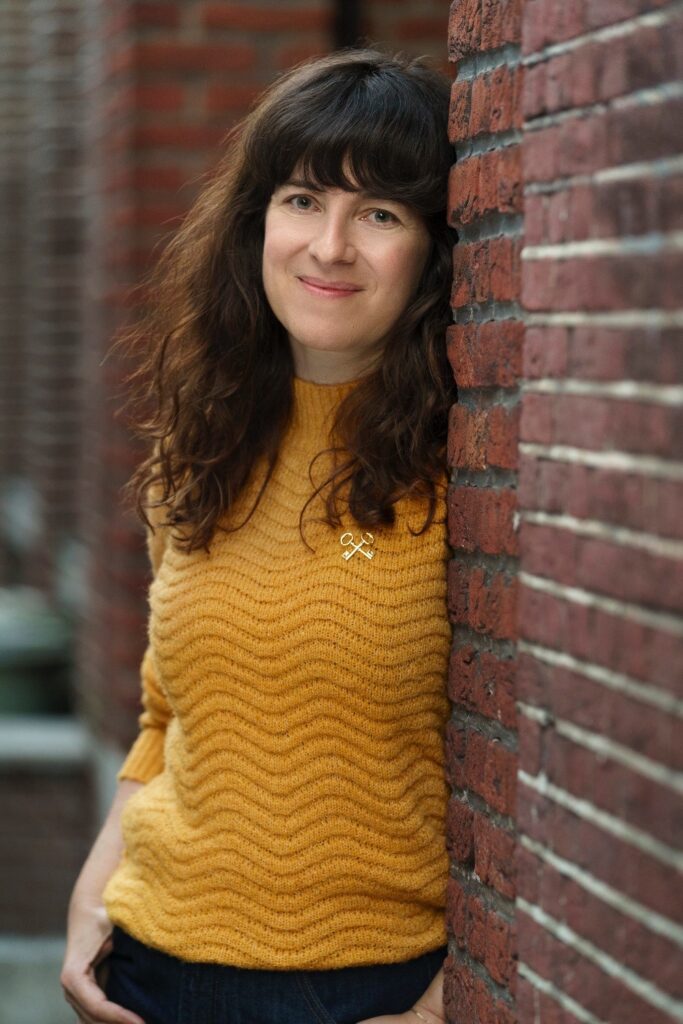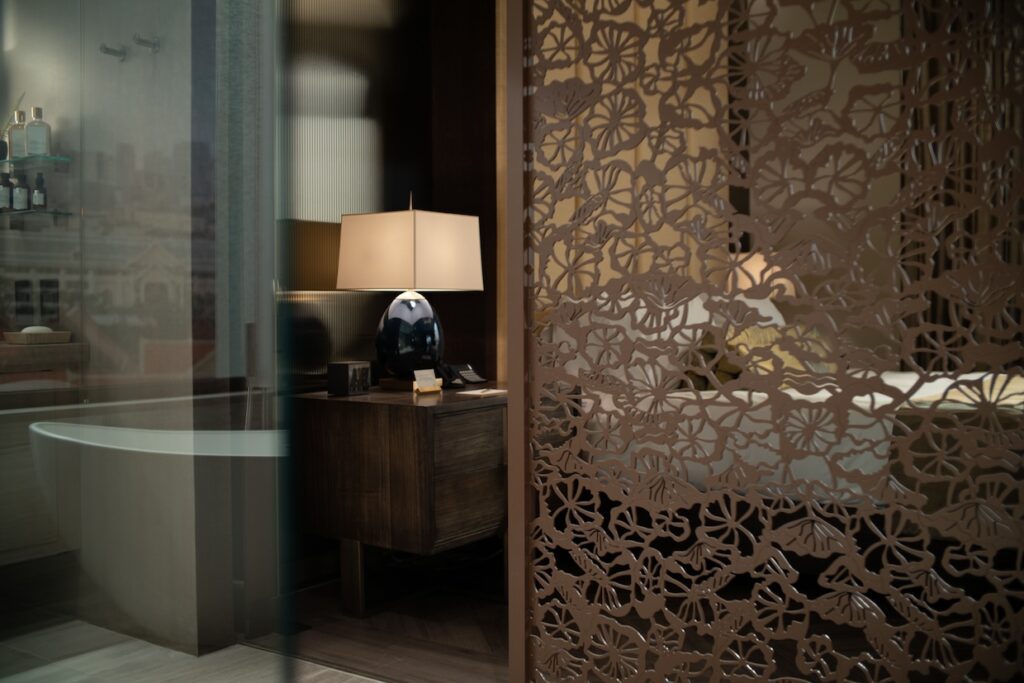 Back to selection
Back to selection
“You Provide Everything That’s in Every Shot”: Production Designer Sara K White and Director Susanna Fogel
 The Flight Attendant
The Flight Attendant Ahead of the first-ever International Production Design Week, the Production Designers Collective has coordinated a series of interviews with directors and production designers, in which they discuss their working dynamics and mutual passion for the craft of storytelling.
In the first episode of The Wilds, one of the main characters is introduced via a quick beat of her smoking a cigarette on her family’s back deck with a nicotine-stained, pink flamingo ashtray nestled on the rail nearby. Sara K White, the show’s production designer, recalls: “We were working to build out Dot’s character—a girl who doesn’t come from money and is taking care of her dad, her only family, who’s likely terminal from throat cancer. So, she has a hard life, but has a quick wit and isn’t afraid of gallows humor. She was supposed to be standing against the house, but we found this funny little flamingo and they changed her blocking so we could incorporate it.”
It’s the kind of character detail White has learned writer-director Susanna Fogel appreciates and will change the staging of a scene to include. While The Wilds was their first collaboration, the two have also teamed up on the Emmy-award-winning show The Flight Attendant and the upcoming feature Winner. Below, they discuss the importance of understanding character psychology, building mystery into the sets of The Flight Attendant and the joy of specificity.


Filmmaker: Can you tell us a bit about your first collaboration on The Wilds—how you approached the creative process and what common ground you found as collaborators?
Fogel: The thing I respond to when looking for department heads is whether they understand the characters from a deep psychological place. This is my bias as the child of two shrinks. But I’m always thinking about characters—not just the surface level of how you would describe them from the outside, but also who they are, their interior life.
That first project, The Wilds, was about teenage girls. There’s a deep psychology to each one and a deep layering to their characters. One thing that immediately struck me about Sara was that she was talking about them and analyzing them with insight and empathy. We were able to talk about, “What is in this person’s bedroom? What does she think she’s projecting versus what is she actually projecting?” It wasn’t just, “This girl likes sports, so there’s sports memorabilia in her room.” It was more like “She thinks she’s this, but really this is her, this is her self concept.” Aesthetically, everything else stems from talking deeply about characters. If you’re on the same page about that, then I love letting somebody like Sara do what she does, then we can pick from different options that all feel like they’re within the world that we both understand intuitively.
White: I think that’s why we work so well together, because I feel the same way: every person is coming from a background they have no control over, and they’re existing within that framework. Then they have society’s framework around them in their present day—who they are internally and how they want to exist in the world, how they feel free or not free to exist in the world, how that manifests around them, what forces are impacting their everyday life. How can that can be represented in a way that the audience can then also understand, if not from a conscious way, at the very least from a subconscious way? That’s really the part about doing this job that is so fascinating to me. That’s what allows for characters to really connect to an audience, and I’m interested in helping to make that connection. So, being asked to consider the characters with someone like Susanna, and dig into those people and have that back and forth about how this person is going to represent themselves and what they feel is important about themselves, that’s the part that gets me really excited.
Fogel: Another really fun component of directing is using Sara’s choices as a jumping off point for some of my choices. When I’m making a shot list, I’ll often look at transitions between scenes. That’s a place I like to start focusing when I’m figuring out where we’re putting the camera. Oftentimes, if we’re introducing characters, I will specifically start on a shot of something that really represents this person. So, I can say “Sara, find me something that is so this person.” I like to feature the design in that way too.
It’s the symbiotic thing where we start wrapping our heads around the characters together. We’re spitballing about them with the shorthand that we have. Sometimes I’ll specifically want to feature something we haven’t picked yet, but I’ll know that’s a way I want to start the scene. It’s really fun to have a really bespoke assignment like that together.
Filmmaker: Jumping right into The Flight Attendant, one of the many alluring aspects of the show is the journey you take with the main character through many locations: Bangkok, New York, Rome etc. What was the thought behind creating a consistent aesthetic with so much geographic variety?
White: One thing I made sure to integrate into all the primary sets was the idea of constant shifting perspectives and allowing for the camera to capture those shifting perspectives. So, as many times as I could, there was almost a maze-like element to the different sets, and that allowed for a similar feeling, a consistency, in the way Cassie was captured in them. We definitely did have variation between the materiality and color palettes in a lot of the locations—Bangkok was intended to feel very different than say her New York apartment. But Cassie inhabits all of it and we’re in her perspective. So, having the richness, the brightness of her character be pervasive, was important for me to communicate.

Fogel: Yeah, I always think about scenes as if you’re telling the story in a graphic novel where there’s one panel that represents what each scene is. What’s the iconic image of each scene that says it all? And for that, the throughline is really her psychology. As long as you’re true to what that is, then it feels like it’s of a piece, you know? As I move through my life, I can be in a really messy bedroom or a really glamorous hotel, and I’m still myself in both of those spaces.
Filmmaker: Thinking about production design overall, is there anything you both are drawn to or notice when you’re watching other films or shows? What makes for good production design?
Fogel: For me, a lot of it is the specificity of the choices. I can tell when something feels really intentional and deliberate and specific. And that goes for every aspect of it—costumes, production design, performances. I notice if something feels like there’s a specific intention that’s being achieved, whether that’s a shot in a Wes Anderson movie where there’s a certain goal and a certain palette and everything is very designed down to the letter, or it’s something else. If it feels like there’s a real vision that was executed, it almost doesn’t matter what that vision was. If it feels like it was delivered on in a specific, complete way, then I think it’s good.
White: If you feel like the situation that you’re watching is being enhanced by the surroundings, the set or the props—sometimes that’s very invisible, and it shouldn’t be something that is necessarily seen in a forward way in every scene or set or project. But if you’re able to look behind the character and feel like you’re gaining insight, that’s when it really is successful design.
Fogel: That’s how I feel too. I also feel like if something is a really big misstep, it’s distracting to me, if you can feel something is an affectation of the filmmaker that doesn’t belong in the world of the movie. I appreciate a nerdy specificity in all the choices ending up onscreen.
Filmmaker: Is there anything else you’d like to say about the designer/director collaborative relationship? Or any goals for continuing the conversation around that relationship?
White: For me, it’s definitely about bringing more knowledge to what the art department is. I’ve been doing press for my most recent project and working on reaching out for International Production Design Week. And there are a number of interviews or conversations that I’ve had that begin with: “So, what does a production designer do? What is production design?” Because we do so much, having that knowledge out there a bit better, so that people can understand how much we offer to a project and what responsibility we carry during a project, that will help us to continue to do our job well. That’s something I’ve been thinking about quite a bit.
Fogel: I feel like the work of a director is really to find people that are incredible at what they do, then let them do it. And with production design, you know that’s what’s on camera. It’s what Sara provides. There are performances, there’s how we’re shooting it, but everything in the shot is something that Sara put there. I don’t know what’s a more important job than that on a set—she’s filling the frame with things. Sometimes directors get credit for doing every job, and actually they don’t. The most important job they do is to find the best people. The last few projects I’ve done, all had really strong production designers. And they’re the first person I talk about when I talk about what makes the look of the film. It always starts with that person. So, I’m glad to be elevating that role however I can, it’s an all-important job. It shouldn’t be confusing to people. What do you do? You provide everything that’s in every shot.
To check out the complete program of International Production Design Week, go to productiondesignweek.org
